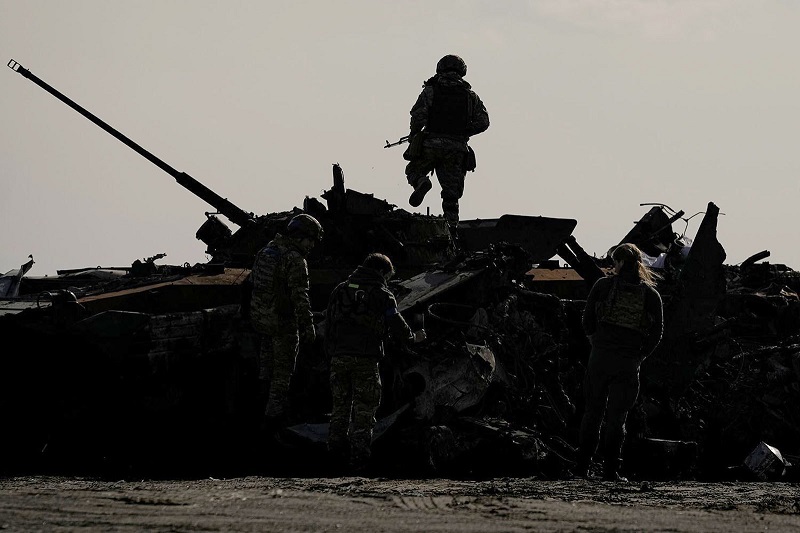transform! europe has launched a new Economic Working Group (EWG) in 2023 to respond to the current crises caused by late capitalism. This first article of the EWG blog series looks at some aspects of the financial crises that punctuate the history of modern capitalism.
This article is part of transform!’s Economics Working Group Blog Series.
transform! europe has set up a new Economics Working Group (EWG) in 2023 to react to the current crisis posed by late capitalism, which is causing an invisible cost of living crisis while at the same time increasing climate heating. This crisis is often described as a multiple or poly-crisis, while it has a single root: worldwide capitalism. The last few weeks have once again proved this root crisis when the collapse of a single regional bank in the West of the USA triggered a banking crisis that led to the spectacular collapse of one of the world’s 30 so-called “systemic banks” in Switzerland – a bank too big to fail. The Swiss government forced the merger of Credit Swiss with UBS (Union de Banques Suisses) to avoid a global meltdown of the financial system. Has the problem been solved and brought under control? Far from it. The government has only postponed a much bigger crisis to come, as the new bank now has a combined balance sheet twice the size of Switzerland’s GDP. There is no possibility whatsoever that the Swiss state will be able to keep this financial institution alive when the next crisis hits the financial system. In this brief paper, Luca Lombardi presents a concise and precise analysis of where this near meltdown comes from and puts forward four concrete demands to solve the threats that the liberalised financial sector poses to our societies.
Roland Kulke
Financial crises punctuate the history of modern capitalism. In the same way as wars, financial crises are the consequence of the impossibility of the ordinary mechanism of capital accumulation to continue, although there are of course other causes. Moreover, like wars, they entail the demise of the weakest contenders and are ended by the full mobilisation of state resources. Discussing the nature of war, Carl von Clausewitz observed that it “could be more accurately compared to trade, which is also a conflict of human interests and activities; and it is still closer to politics, which in turn may be considered as a kind of commerce on a larger scale” (Clausewitz, 1976, p. 100). If we add the financial crisis to this picture, we get a wonderful synthesis of the links between war, politics and crises.
Each crisis has its own specific causes, which must be analysed in order to understand it, but above all they always have the same mechanism, which can be summed up as the need of capital to be accumulated at the maximum possible speed. The nature of capital is to overcome any limit, and anything that is posed as a limit is rejected like a cell that is foreign to the organism, as Karl Marx noted: “The real barrier to capitalist production is capital itself”. Paradoxically, the more capital succeeds in growing, the more obstacles it creates to itself on the road to accumulation, and therefore it is forced to resort to external aids. There are basically two: the state and the banks.
It was a profound Minsky’s intuition: the idea that the growing role of finance implied a growing role for public finance (Minsky, 1986). It was not easy to defend this analysis in the Thatcher-Reagan era, when the State seemed an old relic ready to be dismissed. Minsky explained that the bigger the banks and financial markets, the bigger the role of central banks and government in the economy must be. In reality, the rollback of the State never happened, because without the implicit or explicit public insurance on their activities, banks cannot survive for long. What has changed is the nature of the public role in the economy, which is now geared towards supporting capital accumulation and the growth of financial markets. A particularly clear example is social security, which has been undermined thus the fact that it has helped private pension funds to grow. Today, the financial markets and the State are like two objects suspended from the arms of a balance. If the weight of private finance increases, the other must also increase in order to keep the equilibrium. This idea is very different from the mainstream narrative of public debt crowding out private investment. The reality is that the modern investment machine is based on financial markets (equity, bond, credit, derivatives, etc.) and cannot survive without the balancing act of government.
The business model of banks is inherently fragile
This applies both to their liabilities and to their assets. The liabilities of banks are mainly composed of deposits, some of which are the savings of workers and the non-reinvested profits of companies, and some of which are directly created by banks in their credit function. The possibility for banks to create money (so-called “endogenous money”) has often been denied by mainstream economics, albeit with exceptions (McLeay et al., 2014; Jakab and Kumhof, 2015). In reality, banks are able to finance investment and financial speculation precisely because they can create money at will. Broadly speaking, they should create an optimum amount of money associated with the expectations of their customers, firms and households, to repay their debts, but no one knows ex ante what this amount is. Moreover, each bank tries to create the maximum part of the optimum quantity, creating an overall effect of financial bubbles followed by a credit crunch. The fact that almost all the money we use to buy anything (i.e. our bank deposits) is created by private intermediaries for profit-maximising purposes makes a public role essential. Public lending of last resort, deposit insurance, and banking supervision are tools created over the centuries to prevent the destruction of the economy by private banking behaviour.
Regarding assets, banks should select their debtors carefully, but the more loans they grant and the more assets they buy, the more profits they make. So prudence is an enemy of banks, imposed on them by public authorities. However, central banks and governments tend to be very close to the interests of the big banks. As Johnson noted: “Oversized institutions disproportionately influence public policy” (Johnson, 2009). This was true decades ago, but nowadays banks have become so big that they simply cannot be contradicted for the survival of a national economy. To take an extreme example, the proposed merge of Credit Suisse and UBS will create a bank with total assets more than twice the size of Switzerland’s GDP. It is not just a issue of lobbying or revolving doors, but a total annexation of public institutions into the realm of financial capital (Johnson and Kwak, 2010). After each major crisis, public authorities and international standard-setters such as the Basel Committee try to implement stricter rules that, while useful, do not eliminate future problems but only make the sector less contestable, thus favouring the big banks once again. The growing need for debt to keep the investment machine going defines what we call ‘financialisation’ (on this: Palley 2007; Whalen 2017). It makes banks increasingly important to the world economy, and the latter increasingly fragile.
If financial crises are inevitable, their lightning speed is also connected to the bank’s business model. We often hear that the value of money and the survival of banks is a matter of trust. This derives from the fact that the banks’ business model is based on a mismatch that may seem foolish. While most of their liabilities are deposits and can therefore be called in by their clients at any time, their assets tend to be long-term (think of a 10-year bond or a 25-year mortgage). This structural mismatch is unavoidable because it is the raison d’être of banks: they exist because they centralise liquidity and use it to fund firms and households. This is why bank runs have always been a mortal threat. Even worse, a run on a bank can easily spread to other banks, destroying the banking system in a matter of weeks or days. No private solutions to this issue have ever been found, and nowadays public insurance schemes, such as the FDIC in the US, ensure that everything should go smoothly.
Increased vulnerability to crises due to deregulation or market-friendly regulation
Banking regulation and public control of banks in general have been developed in the aftermath of the 1929-1931 double crisis and have allowed stability in financial markets for decades. It was called the era of “financial repression” because banks were State-owned or strictly regulated, capital mobility was low and financial capital was not free to operate. From the 1980s onwards, public regulation was scrapped or downplayed. Deregulation or market-friendly regulation was considered more efficient because banks knew better. But the more financial markets were deregulated, the more prone they became to crises. In 1992, the EMS (the European Monetary System, which regulated the European currency before the Euro) collapsed, ejecting Italy and Britain out of the mechanism. Financial speculators fought a bloody battle against important central banks and won. This did not change the course of the advanced economies. Privatisation and deregulation continued apace. Then a series of major crises hit developing economies, such as the Asian Tigers crisis in 1996, the Mexican crisis in 1994, the Brazilian and Russian crises in 1998 and the Argentine crisis in 2001. The mainstream economic explanation was that these crises were caused by the underdevelopment of their finance and capitalism in general. They were marred in the typical crony capitalism of Asia or Latin America. As for the dot.com crisis in the US in 2000, that was the beginning of the digital economy. Finally, in 2008, the deepest crisis of modern times hit the world’s most important and advanced financial hubs: Wall Street, the City were devastated by the collapse of markets and banks. Overnight, the endless chatter of economists about “market discipline” was silenced, and State and central banks poured trillions of money into the system to calm the situation.
After 2008, as always after a major crisis, a wave of re-regulation ensued. “No more bailouts from the taxpayers!” was the common slogan. However, as explained above, weaknesses are a key component of the banks’ business model of how money is created and investment is funded. Painful memories of a deep crisis fade rapidly. Thus, in 2011-2012, the meltdown of the Eurozone’s weakest member states, starting with Greece and Cyprus, unleashed the “spread crisis” that threatened to sink the Euro as a whole. Once again, the ECB (European Central Bank) was forced to intervene with unlimited amounts of money. In his famous “whatever it takes” speech, Mario Draghi (who was President of the ECB at the time) formalised this position and ended the crisis (ECB, 2012). For the umpteenth time, public authorities, not market discipline, were the only way out of a financial collapse. Of course, the European banks that bought Greek bonds were saved, but the Greeks were not, and they were forced to make a brutal cut in their living conditions, which was felt in every social indicator. After that, the Banking Union was created in 2014, giving the ECB responsibility for supervising the EU’s biggest banks. Once again, this and other new rules were presented as a vaccine against future crises. The vaccine analogy is used because a few years later, the Covid-19 pandemic broke out, forcing, among other things, central banks and governments to intervene to prevent the collapse of the economy and the banking system. Finally, at the beginning of 2023, the collapse of some medium-sized US banks such as Silicon Valley Bank and the giant Credit Suisse has opened a debate on the possibility of a new general financial crisis.
“It is often said that the solution to a previous crisis becomes the cause for the next crisis”
– B. Mahapatra
This article does not pretend to delve into these recent episodes, but it does touch on some relevant background issues. To save the banks from dying, central banks were forced to keep interest rates at zero after 2008, leading to discussions about a new era of permanent zero interest rates (Bayoumi et al., 2014; IMF, 2017). Free money did not help real investment because economic growth and aggregate demand were weak anyway. It did, however, fuel one financial bubble after another, because this immense liquidity had nowhere else to go. The cryptocurrency bubble was just the most “catchy” of them. This process, which economists call asset inflation, did not worry central banks because it did not interfere with inflation, but only increased the concentration of wealth at the top of society (Mersch, 2020). For instance, the Dow Jones index, the world’s most famous stock market index, quadrupled between 2009 and 2022, while US GDP grew by only 50% over the same period, in other words one eighth of the Dow Jones. When the pandemic and the war in Ukraine blocked supply chains for weeks or months and financial speculation on commodities determined a rapid increase in “real” inflation (i.e. in the consumer price index), the central banks launched rounds of interest rate hikes to provoke a recession and hence stop inflation. We cannot discuss how inefficient, to say the least, this policy is, we can only observe that it determines an increase in the interest rates paid by the State, by companies and by households, increasing the difficulties of debt repayment. And this at a time when the pandemic has already increased public debt.
Banks in Europe, the US and elsewhere have bought up a colossal amount of public debt over the past two decades. At the end of 2022, for example, US banks held $4.4 trillion of it, about 20% of their total assets. Given that every bond has an inverse relation between price and yield (because the coupon rate of the bond is fixed, so the price goes up or down to match the prevailing interest rates in the market as yields change), when interest rates rise, the value of this huge portfolio of public debt accumulates losses. The banks that are forced to sell a significant part of it will suffer huge losses. Many banks will survive these losses, others will not. If investors and depositors panic, the losses of some banks will bring down the entire system. It is interesting to note that, for all their differences, the collapse of mid-sized US banks and the sudden collapse of Credit Suisse were both addressed, as always, with huge amounts of public money in various forms. It is also worth noting that governments have trampled on their own laws in doing so. In the US, for example, federal agencies have insured deposits above the $250,000 limit; in Switzerland, the central bank will take the losses on Credit Suisse’s assets to ensure that UBS buys it, and so on. Complaints that bankers are too greedy and that public money is being used to bail out big shareholders while small savers go under will punctuate the coming weeks, but they are futile. That is how the banking system works. There is no point in condemning the greed of bankers, it would be like complaining about piranhas trying to eat everything that passes by. But the point is that we do not live in piranha infested rivers. We should not live in countries infested by greedy bankers.
Are there alternatives to all this?
As we have seen, tighter rules do not make a real difference during financial crises. Economic experts know this. A famous Financial Times commentator recently observed: “Banks are designed to fail. Governments want them to be both safe places for the public to keep their money and profit-seeking takers of risk. They are at one and the same time regulated utilities and risk-taking enterprises. The incentives for management incline them towards risk-taking, just as the incentives for states incline them towards saving the utility when risk-taking blows it up. The result is costly instability” (Wolf, 2013). In other words, there is no solution.
More effective solutions lie in fundamental changes of the banking landscape
First, they are too big. We have seen that even middle-sized banks can cause havoc in the markets, but when a giant financial conglomerate goes down, the world is dragged down with it. A cap should be imposed on their size, say $250 billion on their assets (Stiglitz, 2009; Singh, 2013; Mastromatteo and Esposito, 2016). In this way, even major banks would be small compared to the government budget, and they would not have an incentive to grow forever. To give an example, in the US, 10 banks would exceed the limit, and the two largest are about ten times as big. In the EU, the situation is even worse. Dozens of medium-sized banks would be far less politically influential and would make the sector more competitive and client-oriented.
A second measure would be to counter the banks’ insatiable profit-seeking by imposing a cap, e.g. on widely used measures of profitability such as ROE (return on equity) or ROA (return on assets), to prevent top management from pursuing ever more aggressive profit-raising strategies. For example, the CEOs of 7 US banks are each paid more than $20 million a year (for the situation in Europe, see EBA, 2023).
A third idea is the outright abolition of bonuses and other variable compensation schemes for top management, thus removing the incentive for bankers to risk the health of the world economy for more money for themselves. These are all sensible ideas, although politically unfeasible due to the strength of the big banks.
To make them realistic, the big banks should be returned to the state. The fourth measure is that banks should be nationalised and run like hospitals and schools, as they provide essential services to the community. Banks larger than, say, 10% of GDP should be nationalised, instead of nationalising their losses during crises and keeping the profits in good times. Today, for example, this would affect 5 banks in France, 2 in Germany, 3 in Italy and 4 in Spain.
“The war which is coming is not the first one. There were other wars before it.”
– B. Brecht
By drawing an analogy between wars and financial crises, some of their characteristics and their ultimate common origin have been highlighted. It should be added that the world will only be able to deal with the former if it is able to deal with the latter.
Luca Lombardi holds a degree in economics and a doctorate in economics. He has worked in the banking sector for 25 years. He is an expert in banking regulation and financial stability.
References
Bayoumi T. et al. (2014). Monetary Policy in the New Normal, IMF Staff Discussion Note no. 14/3, Washington.
Clausewitz C. (1976). On War, Oxford University Press, Oxford.
EBA. (2023). EBA Report on High Earners. Data as of End 2021, EBA, Paris.
ECB. (2012). Speech by Mario Draghi, President of the European Central Bank, Global Investment Conference, London, 26 July.
IMF. (2017). Negative Interest Rate Policies – Initial Experiences and Assessments, IMF Policy Paper, August.
Jakab Z., Kumhof, M. (2015). Banks are not intermediaries of loanable funds — and why this matters, Bank of England Working Paper no. 529, Bank of England, London.
Johnson S. (2009). The Quiet Coup, The Atlantic, May.
Johnson S., Kwak J. (2010). 13 Bankers. The Wall Street Takeover and the Next Financial Meltdown, Vintage Books, New York.
Mastromatteo G., Esposito, L. (2016). Minsky at Basel: A Global Cap to Build an Effective Postcrisis Banking Supervision Framework, Levy Economics Institute Working Paper no. 875, Annandale-on-Hudson.
McLeay M. et al. (2014). Money creation in the modern economy, Bank of England Quarterly Bullettin no. 1, Bank of England, London.
Mersch Y. (2020). Asset price inflation and monetary policy, ECB, Luxembourg, 27 January.
Minsky H. P. (1986). Global Consequences of Financial Deregulation, Washington University Working Paper no. 96, St. Louis.
Palley T. I. (2007). Financialization: What It Is and Why It Matters, Levy Institute Working Paper no. 525, Annandale-on-Hudson.
Singh A. (2013). Too Big to Fail Bank: Examining the How of Breaking Up, Harvard University, Cambridge
Stiglitz J. E. (2009). Too big to fail or too big to save? Examining the systemic threats of large financial institutions, Hearing before the Joint Economic Committee Congress of the United States of America of the One Hundred Eleventh Congress, First Session, April 21.
Whalen C. J. (2017). Understanding Financialization: Standing on the Shoulders of Minsky, Levy Economics Institute Working Paper no. 892, Annandale-on-Hudson.
Wolf M. (2013). Banks are designed to fail — and they do, Financial Times, 14 March.
This article is part of transform!’s Economics Working Group Blog Series.



